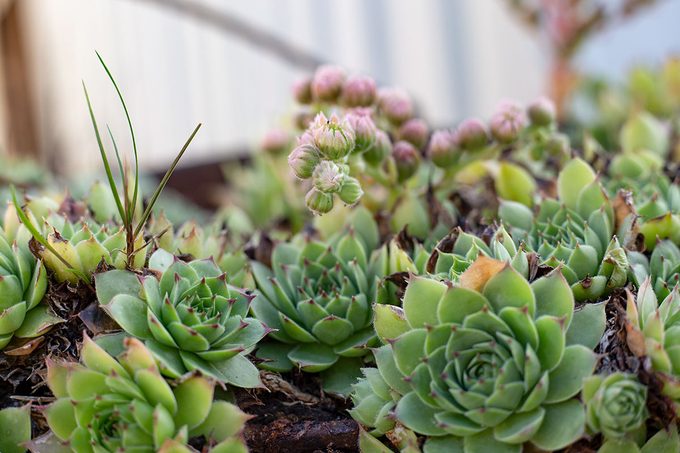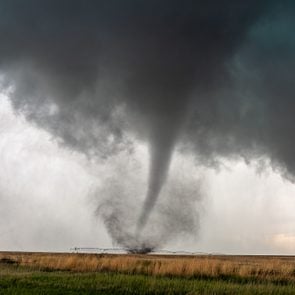We never think a wildfire will affect us … until it does. In the last year alone, we’ve heard news of devastating fires in California, Colorado and all the way to Florida. These fires rage out of control, and it feels like there’s nothing you can do to protect your home. But what if we told you there was?
“Studies have shown that hardening the home against ember entry is the No. 1 action you can take to prepare your home against wildfire,” says horticultural educator Erik Blank, the garden lead at the Theodore Payne Foundation for Wildflowers and Native Plants in Sun Valley, California. Some of that “hardening” includes removing particularly flammable plants and trees from the area immediately around your home and instead surrounding it with certain types of fire-resistant plants. These plants may actually help temper the damage from a wildfire, creating a barrier between the flames and your property.
So how does this work, exactly, and which plants can potentially protect you and your property? We spoke with landscape designer Judy Kameon, founder of Elysian Landscapes in Los Angeles, and Erik Blank from the Theodore Payne Foundation, to find out. Read on for all the details, including which plants to consider … and which to avoid.
What’s the danger with plants near your home?
Most plants provide the literal fuel to a fire, and they will quickly go up in flames—right next to your house. “Embers and small flames are the main way that the majority of homes ignite in wildfires,” according to the National Fire Protection Association (NFPA). That’s why the NFPA recommends keeping anything combustible at least five feet away from the exterior of your home—and that includes plants. When plants are too close, they can create what’s called a fire ladder that provides a path for flames, allowing them to quickly move from low ground cover, up to shrubs, to low-hanging limbs and, ultimately, under rooftops and into the eaves of the home.
Since woody shrubs and dry thatch are basically kindling, a single spark could lead to major disaster if plants aren’t well maintained or trimmed far enough away from the building. Blank adds that leaf litter from nearby trees that ends up in the gutter can also pose a threat, as can dried pine needles or dried grasses. And Kameon warns that certain types of trees, like eucalyptus or palms with a lot of thatch, are also problematic in the event of a fire for the same reason.
What type of plants could actually protect your home from wildfires?

Succulents! These plants, which are fleshy and packed with moisture, can potentially provide some protection from flames. Think: plants like agave and aloe, as well as portulacaria, which can be found in both ground cover and shrub varieties, says Kameon.
Debra Lee Baldwin, author of the book Designing with Succulents, featured one homeowner who credits her fire-wise landscape for saving her home in a 2017 fire, while eight surrounding homes burned to the ground. This video shows the path of the fire through dried brush and trees, until you get to the lush succulent barrier between the blackened vegetation and the home, which appears unscathed.
How can these fire-resistant plants provide protection?
Succulents are commonly used in drought-prone areas because of their ability to hold water and sustain themselves for long periods without precipitation. Because of all of that stored-up moisture, they are less likely to ignite immediately when faced with fire, unlike vegetation that is dry and woody or has oily sap.
Many folks who credit their fire-wise succulent landscape for helping to spare their home in a wildfire say that the plants on the edge that faced the fire head-on seemed to cook rather than burn. Think of it in terms of a marinade: We add moisture to meat to keep it from drying out on the grill. In the same way, the moisture stored in most succulents prevents them from burning up completely before the fire moves on.
While you may think of succulents as easy-to-care-for potted plants for a desk or container garden, they propagate rather easily and can grow to become quite large and even tree-like. “The modern photographer Julius Shulman planted something like two acres of crassula as a fire break,” notes Kameon.
Ultimately—and this is important—there’s no such thing as a fireproof plant. Succulents are fire-resistant and create a fire break, which can potentially lead to a gap in the path of a fire that hopefully causes it to die out or move past your property.
What types of succulents work well?
The following succulents are often lauded for their fire-resistant properties, according to Kameon. Aim for a mixture of ground cover and shrub varieties using the landscaping practice called Defensible Space, which Blank explains aims to “create an obstacle course for embers.”
- Agave
- Aloe
- Crassula
- Aeoniums
- Euphorbia
- Opuntia (cactus)
- Portulacaria
Can you plant succulents anywhere in the U.S.?
Not all succulents will thrive everywhere in the United States. Most succulents prefer hot and dry regions, so folks living in areas susceptible to frost or heavy rainfall might not have as much success growing them outdoors. “Knowing the natural location of the succulent you’re working with will help you provide the optimum location in your garden,” says Blank.
Some succulents, like chaparral yucca, are adapted for extreme heat and sun exposure, he says, while others are more suited to milder environments. Kameon points out that some succulents can actually withstand frost or freeze. The iconic rosette “hen and chicks” succulent, for example, is known to be cold hardy in temperatures as low as 30 degrees Fahrenheit. Some agave varieties (like Queen Victoria agave) can withstand even colder temps into the teens. Check with your local fire department or municipality to see if they have a list of recommended plants for your region.
Could any other plants provide protection from fire as well?
Some native plants are known as “ember catchers.” According to Blank, “the California Coast live oak is the poster child for ember catchers in Southern California” because they have thick leaves and tough bark and hold lots of moisture. These ember catchers will vary by region, so check with your local municipality for suggestions.
Blank notes that there’s a neighborhood called Christmas Tree Lane that has large deodar cedar trees lining the street, and many believe that these trees protected the homes from flying embers during January’s Altadena fire. “We often put it this way,” he says. “It’s easier to start a campfire with smaller, drier material than it is to start with large, green logs.”
The maintenance and hydration of your plants are what could make them fire-resistant, so you can certainly consider options beyond succulents. A garden that is frequently cleared of dry brush and thatch (including wood chips and pine straw, which could also serve as ignition sources) and watered to keep the vegetation green and thriving could be just as effective as a succulent garden if that’s what’s right for your area. “Lean, clean and green” should be the mantra that guides your planting decisions, says Blank.
Why else are native plants a good idea?
Native plants can be great to have in the event of a fire because even if they are scorched, they will likely regenerate. Plus, native plants are adaptive to the climate. According to Kameon, native plants that are garden tolerant (adapted to having irrigation) are going to be less flammable than some of the drier, more drought-tolerant options.
What types of plants should you avoid?
“Avoid plants with shredding or peeling bark,” says Blank, as that can be another ignition point in the event of a fire. “In California, we have a chamise (an evergreen shrub) called ribbonwood. As beautiful as it is, this is a plant I would think twice about putting on my high-fire-zone property.” Or, at the very least, keep it a good distance away from the house (much more than five feet).
Some herbs, like rosemary, contain lots of oils, which make them particularly flammable. Plus, they can get woody and dry. So be sure to keep your herbs well pruned, and keep them at least five feet from the exterior of your home and away from any flammable tree overhang.
What else will protect your home from fire?
Aim to keep any vegetation (including tree limbs) at least five feet from the house.
Fill those five feet with hardscaping, such as pavers or gravel.
Avoid combustible materials for fencing and decking, particularly in fire-prone regions. Opt, instead, for steel or fiber board.
Look into plants that are native to your region. “They may be more adapted to your natural weather patterns and require less irrigation to keep green,” says Blank. “They will also support local habitat.”
The NFPA recommends incorporating driveways, paths and patios with hardscaping to break up groupings of greenery and provide a fire break.
Man-made materials near the home can also be ignition sources. Think: umbrellas, doormats and vinyl gutters. Consider moving or replacing these with less combustible materials.

How to Prepare for a Tornado

How to Prepare for a Hurricane Right Now

How to Escape a Car That's Sinking